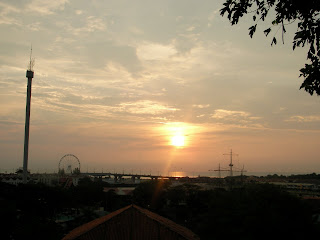Over the long Hari Raya weekend (yes this is a really overdue post), I was in Malaysia with a few friends. To summarise the key activities for 3 full days, it was mainly eat.sleep.eat.birding.eat.sleep.eat.eat.sleep.birding.eat.eat.eat.eat.
The pigging started on the coach ride. We were caught in a severe traffic jam at Tuas checkpoint and it took us nearly 8 hours on the coach! Needless to say, I was unconscious most of the time. It was almost evening when we arrived at our destination. Without much time to lose, we answered to the calls of protest from our stomach before walking to St John's hill for a panoramic view of Malacca - the silhouette of flocks of migratory birds against the sunset was simply breathtaking!
We lingered on the hill for an hour or so, immersing in the melodious bird calls of Asian Koels (Endynamys scolopacea) , Black-naped Oriole (Oriolus chinensis), House Crow (Corvus splendens), Mynas (Acridotheres spp.) etc. We would have stayed on the hill longer if not for the setting sun, and made our way to Jonker street for a night of sovenir shopping.
It was early rise and shine the next morning as we prepare for a trip to Parit Jawa, known for the haven for the Lesser Adjutant Storks (Leptoptilos javanicus).
The first sight that greeted us was rows and rows of fisherboats and stacks and stacks of cages, presumably used for fishing. We were initially rather skeptical and were not sure if we would really see the storks.
Rows and rows of boats
stacks and stacks of cages
As we walked on, a Cabbage Tree (Fagraea crenulata) and the Sea Almond tree (Terminalia catappa) stood side by side and I mistook both to be the same. While both are large trees with obovate, sessile, large leaves and looks fairly similar, their flowers are distinctly different. The Sea Almond has long spikes of many tiny white flowers which lack petals with a star-shaped calyx, flowers of the Cabbage tree are pale yellow/ creamy in colour.
Also, leaves of the Sea Almond turns orange/ red about twice a year, while leaves of the Cabbage tree remains green.
Flowers of Cabbage tree
Flowers of Sea Almond
Its milky sap is said to be poisonous and is used by fishermen to poison fishes.
200m away from where we alighted from the taxi, the stars of the day came into sight!! These large wading birds were about 1.2m tall and their head bore strong resemblance to a vulture. While its looks are not all that flattering, it is on the IUCN Red List of Threatened species, largely due to the small population that is rapidly declining as a result of hunting pressure and lost of habitat.
We soon had to leave (with much reluctance) as dark clouds loomed and it started to drizzle. Although shortlived, we were all satisfied with the sighting of the storks, in addition to the many waders, kingfishers, egrets and an unidentified eagle (check out Samson's posting for splendid photos).
Later I learnt that we have Mr Poh, the protector of Lesser Adjutant Stok, to thank. Without his effort in conserving and protecting the Lesser Adjutant Storks and their habitat, there wouldnt be a lifer for me! We later met Mr Poh in person whom gave us his namecard! Hopefully, there will be future opportunities to explore the area!
It rained rather heavily on this second day, and thus we hibernated most of the time, appearing briefly for dinner (yummy Nonya food at the hotel!) before returning back to the room for more sleep.
The weather on the third day was more encouraging as we set out to St John's hill again for more birding.
On our way past a Noni plant (Morinda citrifolia), we were awed by tens of dancing Painted Jazebel (Delias hyparete metarete) in its usual nonchalant, graceful manner. Its beautiful display of red and yellow not only allows for easy identification, the colours also warn predators of its toxicity that was accumulated during its earlier stages as a caterpillar.
I was looking for the 'Botak' Common Myna whom we saw the day before and was hoping to get a picture of it as a comparison to the Lesser Adjutant. I was disappointed by the absence of the Myna, but was pleasantly pleased with a very cooperative Zorro look-alike - the Black-naped Oriole (Oriolus chinensis) - hopping on a tree less than 5 m away from us. We were really in luck because they rarely descend to the ground and often forage high in trees and usually stay within the canopy.
Finally, I had a chance to get a shot of a bird with my point-and-shoot!
The Black-naped Orioles rank among the top 10 most common residents in Singapore and have adjusted very well to cultivated areas, parks and gardens. So, slow down your pace and keep a lookout for it on your way to work, and you will have a good chance of seeing the bright yellow birds foraging in the trees.
Despite poor weather, we still accomplished much during the short 3D2N trip. Apart from the enjoyable birding sessions, we also learnt from about the rich heritage of Malacca, and of course indulge ourselves in the tasty offerings of this food paradise!















1 comment:
wow! Fantastic posting. The best blog I ever read about short trip to Malacca!!
Post a Comment